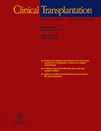Depressive symptoms and mortality in lung transplant
The project described was supported, in part, by Award Number KL2RR025746 from the National Center for Research Resources. The content is solely the responsibility of the authors and does not necessarily represent the official views of the National Center for Research Resources or the National Institutes of Health.Joe Galanko is supported by NIH Grants DK 034987 and DK 056350.
Abstract
Evon DM, Burker EJ, Galanko JA, Dedert E, Egan TM. Depressive symptoms and mortality in lung transplant.Clin Transplant 2010 DOI: 10.1111/j.1399-0012.2010.01236.x. © 2010 John Wiley & Sons A/S.
Abstract: Objective: To determine whether depressive symptoms predicted survival before and after lung transplantation. We hypothesized that depressive symptoms might predict survival of wait-listed patients, but would not predict survival post-transplant.
Methods: This was a prospective, longitudinal study. Participants completed the Beck Depression Inventory pre-transplant. Pre-transplant survival analyses were conducted (n = 124) based on time from list date, to death, transplant, or censoring, if still alive. Post-transplant survival analyses were conducted (n = 76) based on time from transplant, to death or censoring. Cox proportional hazards regression analyses were utilized.
Results: In the unadjusted model, depressive symptoms predicted mortality for candidates awaiting lung transplant (p = 0.02); however, once models were adjusted for demographics and pulmonary status, the relationship between depressive symptoms and mortality rates was attenuated (p > 0.05). Depressive symptoms did not predict survival after lung transplant (p > 0.05).
Conclusions: Pre-transplant depressive symptoms were associated with mortality among lung transplant candidates in an unadjusted model and a model fit with demographics and forced expiratory volume in one second. Depressive symptoms do not exert an independent effect when forced expiratory vital capacity is added. Depressive symptoms do not predict mortality after transplant. Future studies need to determine whether pre-transplant psychosocial characteristics confer a greater risk for poorer transplant outcomes.




